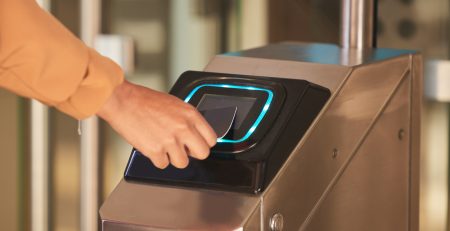Biometric Technologies in the Public Sector
Security in the public sector is a crucial priority, and biometrics are revolutionizing the way we control access and ensure the protection of government facilities. Let's explore the advantages and how to implement these technologies effectively.
What is Biometrics?
Biometrics refers to automated methods of recognizing individuals based on their physical or behavioral characteristics. The most common types include fingerprints, facial recognition, iris recognition, among others.
Types of Biometrics
Fingerprints
Fingerprinting is the most widespread biometric technology, using the unique characteristics of fingertips to identify a person.
Facial recognition
Facial recognition uses algorithms to map the features of a person's face and compare them to a database, allowing accurate identification.
Iris Recognition
This method examines the unique patterns in the eye's iris, offering one of the highest levels of accuracy in biometrics.
Importance of Biometrics in Access Control
Increased Security
Biometrics offers a much higher level of security than traditional methods, such as passwords or access cards, which can be easily lost or stolen.
Accuracy and Reliability
Biometric systems are highly accurate and reliable, significantly reducing the possibility of forgery or misidentification.
Convenience and Efficiency
Biometrics eliminates the need to remember passwords or carry access cards, making the entry process faster and more convenient.
Implementation of Biometric Technologies
Needs Assessment
Before implementing any technology, it is essential to evaluate the specific needs of the location. Identify the areas that most require strict access control.
Choice of Equipment
Select high-quality equipment that meets your specific needs. Consider factors such as durability, accuracy and ease of integration.
Integration with Existing Systems
It is essential that biometric systems are effectively integrated with existing security systems to ensure smooth and flawless operation.
Compliance with Law 14,133/2021
Bidding Procedures
Law 14,133/2021 establishes clear guidelines for bidding on biometric technologies. Follow legal procedures to ensure transparent and fair hiring.
Supplier Selection Criteria
Choose suppliers based on criteria such as equipment quality, market experience and technical support offered.
Success Stories in the Use of Biometrics
Pioneer Cities
Several cities around the world have already successfully implemented biometrics to improve public safety. These cities report a significant reduction in security incidents.
Impact Statistics
Studies show that implementing biometric systems can reduce verification time by up to 70% and increase security by up to 90%.
Challenges and Ethical Considerations
Privacy and Security
Protecting citizens' privacy is crucial. Biometric systems must be designed to ensure that personal data is stored and used securely.
Transparency and Responsibility
Authorities must be transparent about how the technology will be used and ensure there is accountability in data management.
Future of Biometric Technologies
Artificial intelligence
The integration of artificial intelligence with biometrics is enabling significant advances in the accuracy and speed of identification systems.
New Applications
In addition to access control, biometrics is being used in areas such as electronic payments and health monitoring, expanding its applications.
Conclusion
Biometrics is transforming security in the public sector, offering safer and more efficient methods of access control. With compliance with Law 14,133/2021, the implementation of these technologies becomes even more transparent and effective. If you are looking for integrated access control solutions, C2H Solutions is ready to help. Contact us through our contact page to receive a quote and improve the safety of your community.
FAQs
- What is biometrics?
- Biometrics refers to methods of recognizing individuals based on unique physical or behavioral characteristics.
- What are the most common types of biometrics?
- Fingerprints, facial recognition, and iris recognition are the most common types.
- What are the benefits of biometrics in access control?
- It increases security, provides accuracy and reliability, and is convenient and efficient.
- How to ensure compliance with Law 14,133/2021?
- Following legal bidding procedures and selecting qualified suppliers.
- What are the ethical considerations in implementing biometrics?
- Guarantee the privacy of citizens and maintain transparency in the use of technology.












Comments (14)
💡 A biometrias estão revolucionando a segurança no setor público, garantindo maior proteção e eficiência! Que tal descobrir como essas soluções podem transformar o seu sistema de #Controle de Acesso?
👉 Quer aprofundar seus conhecimentos sobre #Controle de Acesso? Explore mais conteúdos exclusivos em nosso blog na seção #Controle de Acesso.
🤝 Envie um email para nosso departamento comercial! comercial@c2hsolutions.com.br
💡 A biometria está revolucionando a segurança no setor público, oferecendo soluções que garantem maior confiabilidade e agilidade no controle de acesso. Cada inovação traz novas oportunidades para proteger nossos cidadãos!
👉 Quer aprofundar seus conhecimentos sobre #Controle de Acesso? Explore mais conteúdos exclusivos em nosso blog na seção #Controle de Acesso.
🤝 Envie um email para nosso departamento comercial! comercial@c2hsolutions.com.br
💡 A adoção de tecnologias de biometria no setor público não apenas aumenta a segurança, mas também otimiza processos e promove a confiança da população. É um passo crucial para a modernização!
👉 Quer aprofundar seus conhecimentos sobre #Controle de Acesso? Explore mais conteúdos exclusivos em nosso blog na seção #Controle de Acesso.
🤝 Envie um email para nosso departamento comercial! comercial@c2hsolutions.com.br
💡 A tecnologia de biometria está transformando o setor público, garantindo segurança e eficiência no controle de acesso. A adoção dessas soluções não só protege dados sensíveis, mas também otimiza a experiência do cidadão!
👉 Quer aprofundar seus conhecimentos sobre #Controle de Acesso?
Explore mais conteúdos exclusivos em nosso blog na seção #Controle de Acesso.
🤝 Envie um email para nosso departamento comercial! comercial@c2hsolutions.com.br
💡 A implementação de tecnologias de biometria revoluciona a segurança no setor público, garantindo acesso mais seguro e eficiente. Cada inovação traz novas possibilidades para elevar ainda mais o controle de acesso!
👉 Quer aprofundar seus conhecimentos sobre #Controle de Acesso? Explore mais conteúdos exclusivos em nosso blog na seção #Controle de Acesso.
🤝 Envie um email para nosso departamento comercial! comercial@c2hsolutions.com.br
💡 A biometria está revolucionando o setor público, oferecendo segurança e eficiência no controle de acesso. Com tecnologias inovadoras, podemos garantir um ambiente mais seguro para todos! 🔍
👉 Quer aprofundar seus conhecimentos sobre #Controle de Acesso? Explore mais conteúdos exclusivos em nosso blog na seção #Controle de Acesso.
🤝 Envie um email para nosso departamento comercial! comercial@c2hsolutions.com.br
💡 A biometria representa uma revolução na segurança pública, proporcionando não apenas eficiência, mas também maior confiança na identificação de indivíduos. A implementação dessas tecnologias é um passo fundamental para garantir ambientes mais seguros!
👉 Quer aprofundar seus conhecimentos sobre #Controle de Acesso? Explore mais conteúdos exclusivos em nosso blog na seção #Controle de Acesso.
🤝 Envie um email para nosso departamento comercial! comercial@c2hsolutions.com.br
💡 A biometria é uma solução revolucionária para fortalecer a segurança no setor público, garantindo acesso restrito de forma eficiente e confiável. Conhecer as últimas inovações pode transformar a gestão pública em um exemplo de segurança.
👉 Quer aprofundar seus conhecimentos sobre #Controle de Acesso?
Explore mais conteúdos exclusivos em nosso blog na seção #Controle de Acesso.
🤝 Envie um email para nosso departamento comercial! comercial@c2hsolutions.com.br
💡 As tecnologias de biometria estão transformando a segurança no setor público, tornando o controle de acesso mais eficiente e seguro. Não fique de fora dessa revolução!
👉 Quer aprofundar seus conhecimentos sobre #Controle de Acesso? Explore mais conteúdos exclusivos em nosso blog na seção #Controle de Acesso.
🤝 Envie um email para nosso departamento comercial! comercial@c2hsolutions.com.br
💡 A implementação de tecnologias de biometria no setor público é um passo crucial para garantir a segurança e a eficiência dos serviços. Essas inovações não apenas melhoram o controle de acesso, mas também promovem a confiança entre os cidadãos e as instituições.
👉 Quer aprofundar seus conhecimentos sobre #Controle de Acesso? Explore mais conteúdos exclusivos em nosso blog na seção #Controle de Acesso.
🤝 Envie um email para nosso departamento comercial! comercial@c2hsolutions.com.br
#Controle de AcessoTecnologias de Biometria no Setor Público#Controle de AcessoSegurança com Inovação e Confiabilidade – C2H Solutions
#Controle de AcessoTecnologias de Biometria no Setor Público#Controle de AcessoSegurança com Inovação e Confiabilidade – C2H Solutions
#Controle de AcessoTecnologias de Biometria no Setor Público#Controle de AcessoSegurança com Inovação e Confiabilidade – C2H Solutions
#Controle de AcessoTecnologias de Biometria no Setor Público#Controle de AcessoSegurança com Inovação e Confiabilidade – C2H Solutions